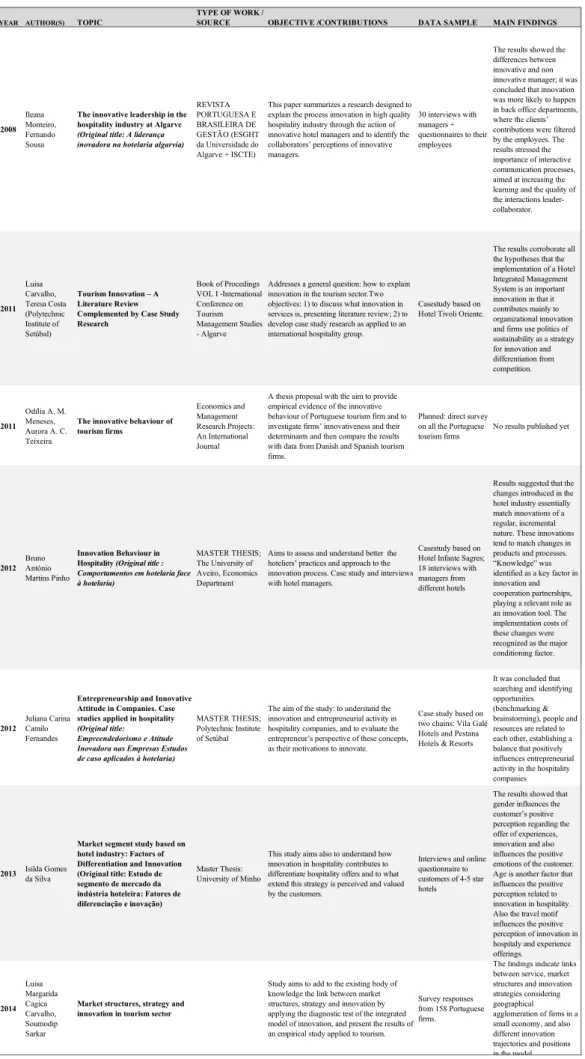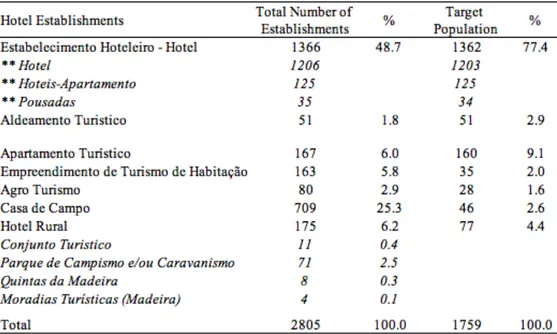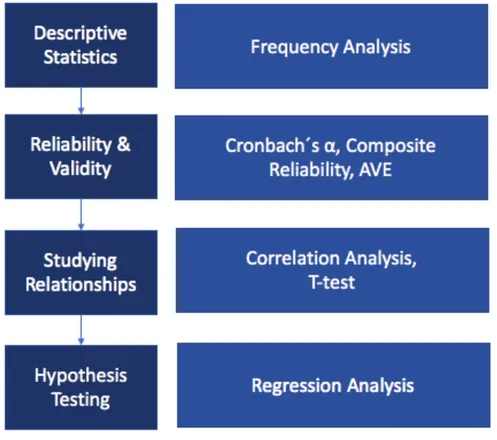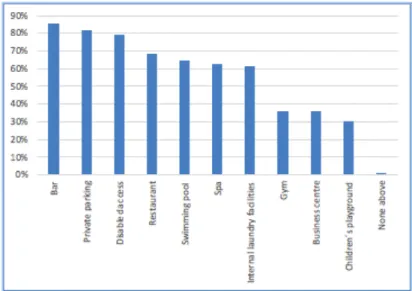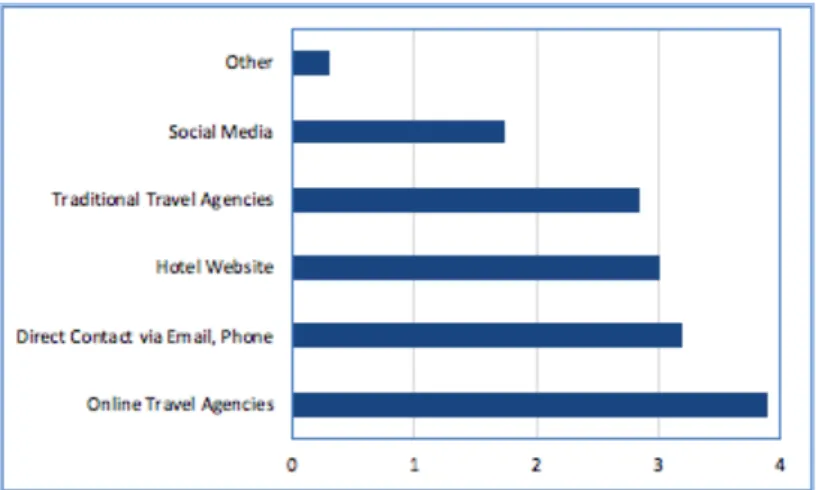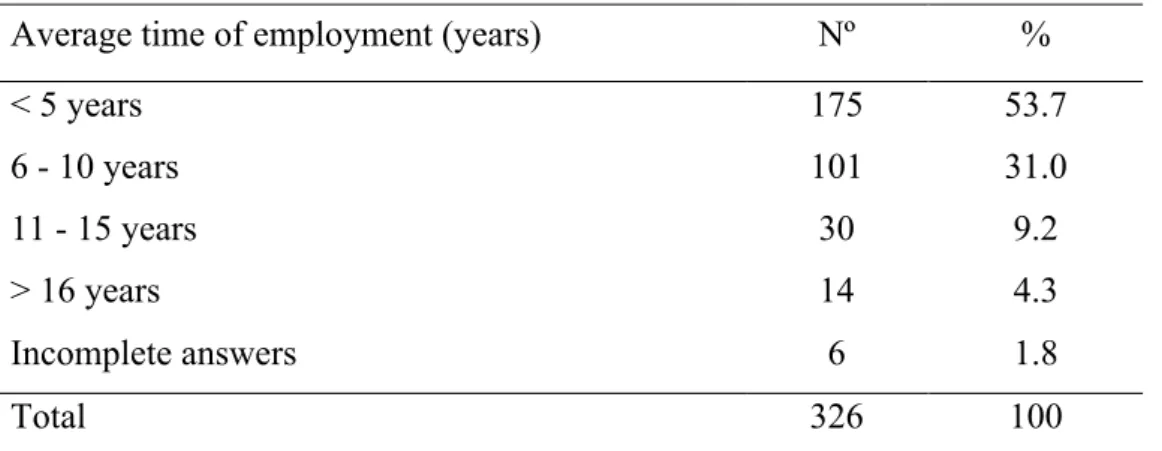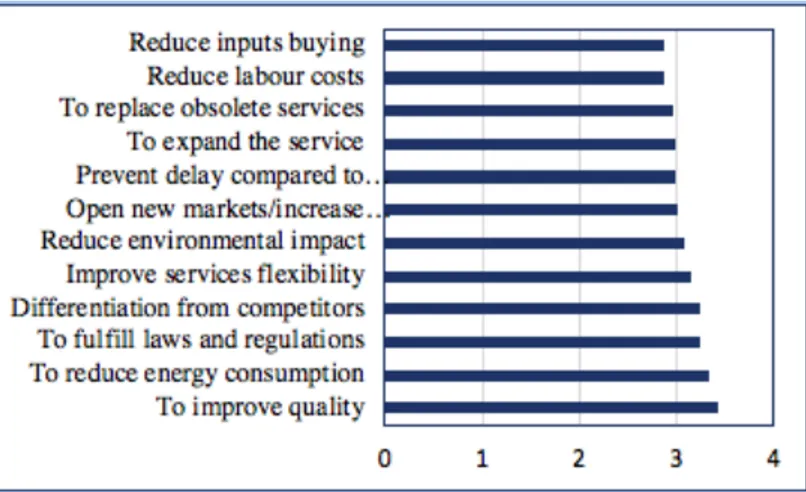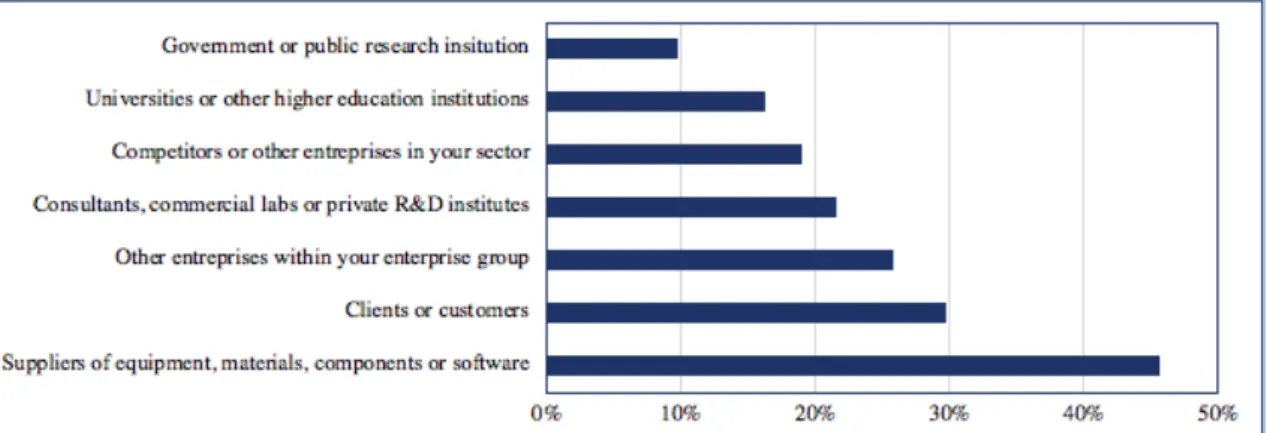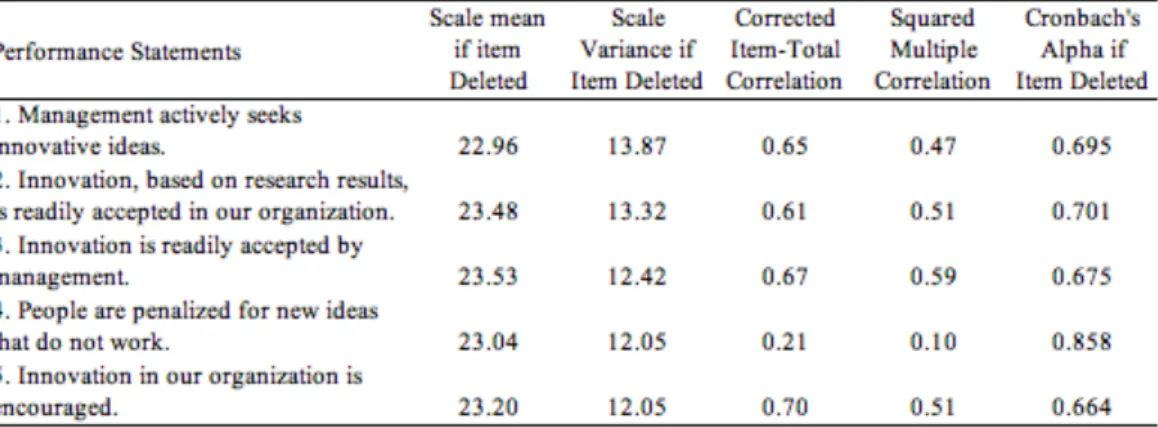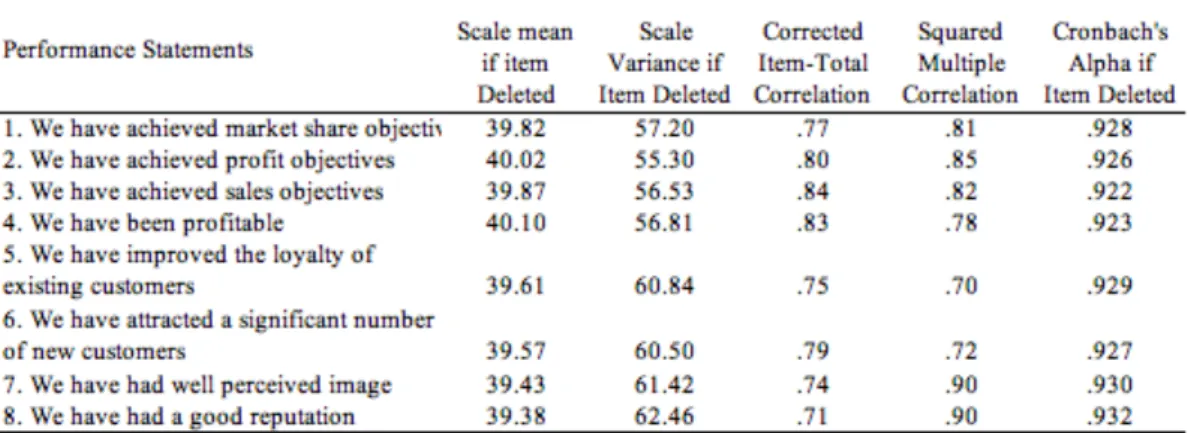Innovation and Performance in Hotel Industry:
Evidence from Portugal
Cleelia Uudam Costa
Thesis specially presented for the fulfillment of the degree of
Doctor in Management with specialization in Strategy and Entrepreneurship
Supervisor:
Dr. António da Silva Robalo Professor Catedrático
ISCTE - Instituto Universitário de Lisboa Co-supervisor:
Dr. Renato Telo de Freitas Barbosa Pereira Professor Auxiliar Convidado ISCTE - Instituto Universitário de Lisboa
III ISCTE Business School
Innovation and Performance in Hotel Industry:
Evidence from Portugal
Cleelia Uudam Costa
Thesis specially presented for the fulfillment of the degree of
Doctor in Management with specialization in Strategy and Entrepreneurship
Jury:
President: Doutora Hélia Maria Gonçalves Pereira, Assistant Professor of ISCTE – Instituto Universitário de Lisboa.
Doutor João Albino Matos da Silva, Full Professor of Faculdade de Economia da Universidade do Algarve;
Doutor António Manuel Ramos Pires, Coordinating Professor of Instituto Politécnico de Setúbal;
Doutora Denise Cristina Cunha Capela Santos, Assistant Professor of Universidade Autónoma de Lisboa;
Doutor Renato Telo Freitas Barbosa Pereira, Invited Assistant Professor of ISCTE – Instituto Universitário de Lisboa (co-supervisor);
Doutor António Silva Robalo, Full Professor of ISCTE – Instituto Universitário de Lisboa (supervisor).
V D ec em be r 2018 December 2018 Innova ti on and P er for m anc e in H ot el I ndus tr y: E vi de nc e fr om P or tug al C le el ia U uda m C os ta Inno va tio n and P er fo rm an ce in H ot el I ndus tr y: E vi de nc e fr om P or tuga l; C le el ia U uda m C os ta
VII ABSTRACT
Together with the growing importance of tourism in world's economy, also the competitiveness of the tourism sector increases. An innovative mindset becomes a necessity for any successful tourism business. This thesis investigates innovation activity in hotels based on empirical evidence from Portuguese hotel industry. The main objectives of this thesis are 1) to analyze the determinants, areas and types of innovation, 2) to measure the degree of innovativeness and impact of innovativeness on innovation behavior, 3) to measure the degree of innovation behavior and impact of innovation behavior on performance.
Current research followed Grissemann, Plank and Brunner-Sperdin (2013) approach splitting the term ‘innovation’ into two different constructs, i.e., innovativeness (attitudinal level) and innovation behavior (behavioral level). Hotel innovation activity based on 11 hotel-specific innovation areas and innovation antecedents such as Hotel Size, Hotel Stars, Hotel Chain and Governance, and Personnel Training were investigated. The empirical data was collected through a questionnaire.
The results, based on a sample of 326 Portuguese hotels, showed high level of Innovativeness of Portuguese hotels. Nearly all hotels had carried out some sort of innovation within the previous three years. Information and communication technology and marketing were the leading innovation areas. The moderate level of innovation behavior showed dominance of incremental innovations. Hotel size, hotel stars, hotel chain and personnel training proved to have a significant relation with Innovation Behavior. Hotel Innovativeness impacted positively hotel Innovation Behavior and hotel Innovation Behavior impacted positively hotel performance. Overall, this research gives a contribution to hotel innovation literature in general and in Portugal. The findings provide hotel managers with relevant insights into hotel innovation.
Keywords: Hotel innovation, Hotel industry, Innovation behavior, Innovativeness, Performance, Innovation determinants
VIII RESUMO
Com a crescente importância do turismo na economia mundial, aumenta também a competitividade no sector. Uma mentalidade inovadora torna-se necessária para qualquer negócio bem-sucedido. Esta tese investiga a inovação hoteleira baseada em evidências empíricas da indústria portuguesa. Os principais objetivos desta tese são 1) analisar fatores determinantes, áreas e tipos de inovação, 2) medir o grau de propensão para a inovação (Innovativeness) e o impacto no comportamento inovador, 3) medir o grau de comportamento inovador e o impacto no desempenho.
Esta investigação seguiu a abordagem de Grissemann, Plank e Brunner-Sperdin (2013) dividindo "inovação" em dois conceitos: propensão para a inovação (nível atitudinal) e comportamento inovador (nível comportamental). A investigação da atividade de inovação baseou-se em 11 áreas específicas. Foram também investigados fatores de inovação, como Dimensão, Classificação por Estrelas, Cadeia Hoteleira e Direção, e Formação. Os dados empíricos foram recolhidos através de um questionário.
Os resultados, baseados numa amostra de 326 hotéis portugueses, revelaram um elevado nível de propensão para a inovação nos hotéis portugueses. A maioria dos hotéis realizaram algum tipo de inovação nos três anos anteriores. As Tecnologias de Informação e Comunicação e o Marketing foram as principais áreas de inovação. Um nível moderado de comportamento inovador revelou um domínio de inovações incrementais. A dimensão, classificação por estrelas, cadeia hoteleira e formação provaram ter uma relação significativa no comportamento inovador. A propensão para a inovação teve um impacto positivo no comportamento inovador e este, um impacto positivo no desempenho hoteleiro. No geral, esta investigação contribui para estudos sobre inovação hoteleira num geral e em Portugal. Os resultados proporcionam à gestão hoteleira ideias relevantes sobre a inovação em hotéis.
Palavras-chave: Inovação Hoteleira, Hotelaria, Comportamento Inovador, Desempenho, Determinantes da Inovação
X ACKNOWLEDGEMENTS
Since I was a little girl, I knew that one day I would take a PhD course, simply because studying was something I always loved.
I am very thankful for ending up in ISCTE that has been part of my Portuguese journey since my first steps in Portugal in 2005. The course of Master in International Management filled me with valuable knowledge for creating my professional path and encouraged me to continue studying and to return to ISCTE.
I am also very thankful to my supervisors Professor António Robalo and Assistant Professor Renato Pereira for the patience, guidance and encouragement they showed during the last five years. And very special thank you to Professor António Robalo, who believed in me and my project since the very beginning.
I have been fortunate to be part of a team of wonderful people who throughout the years have tirelessly translated and spell-checked my Portuguese. Cristina Gokaldas, Cristiana Resende, Sara Teixeira and Joana Pires Vasconcelos, thank you for your kindness and patience. Joana, I am so grateful for all you have done to keep our business running and our team happy.
Special thank you to all the Portuguese hotel managers who participated in the pilot study and responded the questionnaire. It was very kind of you to spend your precious time on filling in this long questionnaire.
And last, but not least, the most important part of my life, my family. Rodrigo, thank you so much for standing by my side all these years with a word of encouragement, an extraordinary amount of patience and love. And my two little daughters, they are the true heroes of my PhD journey. Bravely and selflessly they had to share their precious first years of life with that “elephant in the room”. My family, my rock, my everything!
XII
To My Little Girls..
Dream Big. Everything is Possible.
TABLE OF CONTENTS ABSTRACT ... VII RESUMO ... VIII ACKNOWLEDGEMENTS ... X TABLE OF CONTENTS ... 1 LIST OF TABLES ... 5 LIST OF FIGURES ... 7 I INTRODUCTION ... 9 1.1. OVERVIEW ... 9 1.2. RESEARCH TOPIC ... 10 1.3. RELEVANCE AND CONTRIBUTION ... 11 1.4. RESEARCH DESIGN AND RESEARCH QUESTIONS ... 12 1.5. RESEARCH DIFFICULTIES AND LIMITATIONS ... 13 II LITERATURE REVIEW ... 15 2.1. INTRODUCTION ... 15 2.2. THE CONCEPT OF INNOVATION ... 15 2.2.1. Defining Innovation ... 15 2.2.2. Innovation Models and Popular Approaches to Innovation. ... 18 2.2.3. Typology of Innovation ... 22 2.2.4. Innovation Determinants ... 23 2.2.5. Innovation and Performance. ... 26 2.2.6. Measuring Innovation ... 26 2.3. INNOVATION IN SERVICE SECTOR ... 29 2.3.1. Definition and Theories of Innovation ... 29 2.3.2. Innovation in Tourism ... 33 2.4. INNOVATION IN HOTEL INDUSTRY ... 37 2.4.1. Innovation Determinants ... 38 2.4.2. Innovation Patterns ... 40
2 2.4.3. Innovativeness and Innovation Behavior ... 41 2.4.4. Innovation Behavior ... 42 2.4.5. Innovation and Business Performance ... 43 2.5. INNOVATION IN THE PORTUGUESE HOTEL SECTOR ... 44 2.6. SUMMARY AND RESEARCH QUESTIONS ... 46 2.6.1. Literature Review Summary ... 46 2.6.2. Gaps in Literature and Research Question ... 48 III METHODOLOGY ... 51 3.1. INTRODUCTION ... 51 3.2. RESEARCH DESIGN ... 51 3.2.1. Conceptual Framework and Hypothesis Development ... 51 3.2.2. Questionnaire Design ... 54 3.2.3. Pilot Study ... 58 3.3. DATA COLLECTION PROCEDURES ... 60 3.3.1. Sampling procedure ... 60 3.3.2. Data Collection ... 62 3.3.3. Questionnaire Response and Sample Profile ... 65 3.4. NON - RESPONSE BIAS ... 71 3.5. COMMON METHOD BIAS ... 72 3.6. SUMMARY ... 73 IV DATA ANALYSIS ... 74 4.1. INTRODUCTION ... 74 4.2. DESCRIPTIVE ANALYSIS OF MEASURES ... 75 4.2.1. General Hotel Characteristics ... 75 4.2.2 Innovation Activity in Hotels ... 85 4.3. INNOVATIVENESS, INNOVATION BEHAVIOR AND PERFORMANCE ... 88 4.3.1. Reliability and Validity of Measures ... 88 4.3.2. Innovativeness ... 92 4.3.3. Innovation Behavior ... 94 4.3.4. Hotel Performance ... 97 4.4. INNOVATION DETERMINANTS ... 99 4.4.1. Hotel Size and Innovation Behavior ... 100 4.4.2. Hotel Category and Innovation Behavior ... 101
3 4.4.3. Hotel Chain, Hotel Management and Innovation Behavior ... 103 4.4.4. Hotel Age and Innovation Behavior ... 104 4.4.5. Hotel Personnel Training and Innovation Behavior ... 105 4.5. INNOVATION ACTIVITY IN SMALL, MID-SIZED AND BIG PORTUGUESE HOTELS ... 107 4.6. HYPOTHESIS TESTING ... 114 4.6.1. Innovativeness and Innovation Behavior ... 114 4.6.2. Innovation Behavior and Performance ... 123 4.7. SUMMARY ... 133 V. DISCUSSION AND CONCLUSION ... 136 5.1. INTRODUCTION ... 136 5.2. FINDINGS AND DISCUSSION ... 137 5.2.1. What are the Determinants of Innovation Activity in Hotel Industry? ... 138 5.2.2. What Type of Innovation is Common in Portuguese Hotels? ... 142 5.2.3. What is the Level of Innovation Behavior in Portuguese Hotels? ... 144 5.2.4. What is the Level of Innovativeness of Portuguese Hotels, and How Does the Level of Innovativeness Influence Innovation Behavior? ... 145 5.2.5. How Does Innovation Behavior Influence Hotel´s Performance? ... 147 5.2.6. Innovation Activity in Small, Midsize and Big Hotels in Portugal ... 148 5.3. THEORETICAL IMPLICATIONS ... 151 5.4. MANAGERIAL IMPLICATIONS ... 154 5.5. MAIN LIMITATIONS AND SUGGESTIONS FOR FUTURE RESEARCH ... 156 5.6. CONCLUSION ... 158 REFERENCES ... 163 APPENDICES ... 171 Appendix A. Questionnaire in English ... 171 Appendix B. Questionnaire in Portuguese ... 185 Appendix C. Email Template ... 199 Appendix D. Hotel Types, Innovativeness and Innovation Behavior ... 200 Appendix E. Eleven Innovation Areas in Small, Midsize and Big Hotels ... 201
4 Appendix F. Objectives Fostering Innovation in Small, Midsize and Big Hotels ... 202 Appendix G. Factors Preventing Innovation in Small, Midsize and Big Hotels ... 203 Appendix H. Histogram, P-P Plot and Scatter plot of the Regression Standardized residuals ... 204 Appendix I. Histogram of Performance Before and After Two-Step Transformation ... 205 Appendix J. Histogram and Scatter Plot of Regression Standardized Residuals ... 206
5 LIST OF TABLES
Table 1. Research Papers on Innovation in Tourism in Portugal ... 45
Table 2. Stratification of Hotel Establishments (on 13.11.2014) ... 61
Table 3. Tourist Establishment Type Distribution in Sample and Population ... 67
Table 4. Sample and Population Distribution Based on Hotel Star Category ... 68
Table 5. Number of Rooms/Units and Maximum Capacity of People - Sample Profile and Population ... 69
Table 6. Number of Hotel Employees in Hotel Sample ... 70
Table 7. Hotel Respondents Location Based on NUT 2 Division ... 70
Table 8. Distribution of Hotels Based on Years of Operation (Hotel Age) ... 78
Table 9. Average Length of Employment in Hotels ... 82
Table 10. Human Resources Motivation Practices ... 84
Table 11. Item-total Statistics of Innovativeness Scale ... 90
Table 12. Item-total Statistics of Performance Scale ... 91
Table 13. Correlation Matrix and Average Variance Extracted (AVE) ... 92
Table 14. Cross Tabulation of 11 Innovation Areas and Likert-scale Answers .... 97
Table 15. Correlations of Hotel Size, Innovativeness and Innovation Behavior . 100 Table 16. Hotel Category and Degree of Innovation Behavior ... 102
Table 17. Mode of Business Operation and Innovation Behavior ... 103
Table 18. Hotel Management Arrangement and Innovation Behavior ... 104
Table 19. Hotel Personnel Training and Innovation Behavior ... 105
Table 20. Frequency of Human Resources Practices and Innovation Behavior .. 106
Table 21. Cross Tabulation of Hotel Size and Hotel Establishment Type ... 108
Table 22. Cross Tabulation of Hotel Size and Hotel Star Category ... 108
Table 23. Hotel Innovation Behavior and Number of Rooms ... 110
Table 24. Regression Model Summary ... 117
Table 25. Regression Analysis ANOVA and Coefficients Table ... 118
Table 26. Multiple Regression Analysis Model Summary ... 119
Table 27. Multiple regression ANOVA table ... 120
Table 28. Multiple Regression Model Summary ... 121
6
Table 30. Regression Model Summary ... 127
Table 31. Regression ANOVA and Coefficients Table ... 127
Table 32. Regression Model Summary ... 128
Table 33. ANOVA and Regression Coefficients ... 129
Table 34. Regression Model Summary ... 129
Table 35. ANOVA and Regression Coefficients ... 130
7 LIST OF FIGURES
Figure 1. Flow chart of literature review ... 47
Figure 2. Conceptual framework of the thesis ... 54
Figure 3. Outline of Data Analysis of Current Thesis ... 74
Figure 4. Independent hotels, chain hotels and hotels belonging to diversified business group ... 76
Figure 5. Division of hotel management arrangement ... 77
Figure 6. Hotel physical facilities and features ... 79
Figure 7. Order of importance of guest nationalities ... 80
Figure 8. Sources of hotel reservations ... 81
Figure 9. Factors fostering innovation ... 86
Figure 10. Factors impeding innovation ... 86
Figure 11. Types of innovation cooperation partners ... 88
Figure 12. Histogram and boxplot of Innovativeness ... 93
Figure 13. Histogram and normal Q-Q Plot of Innovation Behavior ... 94
Figure 14. Bar chart of areas of innovation ... 96
Figure 15. Bar chart of performance scale statements ... 98
Figure 16. Histogram and boxplot of Performance ... 99
Figure 17. Hotel type and degree of Innovativeness ... 110
Figure 18. Hotel type and degree of Innovation Behavior ... 111
Figure 19. Innovation Behavior and areas of innovation in small, midsize and big hotels ... 112
Figure 20. Objectives fostering innovation activity in small, midsize and big hotels ... 113
Figure 21. Objectives Fostering Innovation Activity in Small, Midsize and Big Hotels ... 114
Figure 22. Scatterplot of Innovativeness and Innovation Behavior ... 115
Figure 23. Histogram and normal P-Plot of regression standardized residuals of Innovativeness and Innovation Behavior ... 116
8 Figure 24. Scatter plot of regression standardized residuals (Innovativeness vs Innovation Behavior) ... 117 Figure 25. Histogram, P-P Plot of residuals and scatter plot of ... 122 Figure 26. Scatterplot of Innovation Behavior and Performance ... 124 Figure 27. Histogram and normal P-Plot of regression standardized residuals of Innovation Behavior and Performance ... 125 Figure 28. Scatter plot of regression standardized residuals (Innovation Behavior and Performance) ... 126 Figure 29. Histogram, P-P Plot of residuals and scatter plot of multiple regression analysis ... 133
9 I INTRODUCTION
1.1. OVERVIEW
During the last decades the service sector has been growing remarkably next to manufacturing, accounting for a significant proportion of GDP in most countries and catching up in productivity with the manufacturing sector (OECD, 2017). Likewise, the contribution of tourism, as one of the largest service industries, to the world economic growth and international trade is continuously increasing. According to World Tourism Organization (UNWTO, 2018), the year 2017 was the eighth consecutive year of sustained growth following the 2009 global economic and financial crisis. The tourism receipts in destinations around the world grew in 2017 by 5% (reaching 1,340 billion Euros), in conformity with 7% increase in international tourist arrivals (UNWTO, 2018). Also, the share of tourism in world exports and in services exports has been growing, respectively 7% and 30% in 2017. The year of 2017 also marked the eighth year in a row of sustained tourism growth in Europe, the world’s most visited region, with Southern and Mediterranean Europe leading the results in arrivals and tourist receipts (UNWTO, 2018). Similarly, tourism has become an important contributor to Portuguese economy, resulting in 2017 in 18% of total exports and 7.8% of GDP, while creating 7% of all the jobs (Turismo de Portugal, 2018c).
Such growing importance of tourism has also resulted in further development and increase of competitiveness within the tourism sector, where innovation becomes often a condition of survival (Sundbo, Orfila-Sintes and Sørensen, 2007). In hotel industry, which is a vital component of tourism sector, the companies are continuously forced to seek for ways of improving quality, reputation, costs and revenues. Quality and reputation can be improved through innovation, or the ability to develop and launch new and successful hospitality services (Ottenbacher and Gnoth, 2005).
10 Over the past two decades, the research on service innovation has become a large dynamic research area, including an increasing focus on the topic of innovation in tourism (Hjalager, 2010). But nevertheless, different scholars agree that innovation in tourism is still a young phenomenon, requiring further empirical studies in different environments in order to address different aspects of innovation and contribute to elaboration of theory (Hjalager, 2010; Pivčević and Petrić, 2011). This thesis aims to contribute to the tourism innovation literature by investigating innovation activity in hotels based on empirical evidence from Portuguese hotel industry. Additionally, it intends to contribute to the knowledge of innovation activity in Portuguese hotel industry, which so far has been only vaguely studied.
1.2. RESEARCH TOPIC
The main purpose is to investigate innovation activity in hotels based on empirical evidence from Portuguese hotel industry. Taking as reference different approaches to innovation studies in hotel sector (Grissemann, Plank and Brunner-Sperdin 2013; Orfila-Sintes et al. (2005), Orfila-Sintes and Mattsson, 2009), based on a conceptual framework, this investigation intends to elaborate an empirical support to allow to identify and analyze the determinants and patterns of innovation activity and its impact on performance in Portuguese hotel industry.
The thesis aims to analyze the degree and impact of innovativeness on innovation behavior, the areas and types of innovation practiced, the level of innovation behavior and its impact on business performance. Additionally, also to compare the innovation activity of small, midsize and big hotels to provide a groundwork for benchmarking innovation activities in Portuguese hotel establishments. Based on these objectives, the proposed research topic is stated as follows: Innovation and Performance in the Hotel Industry: Evidence from Portugal
11 1.3. RELEVANCE AND CONTRIBUTION
The proposed research topic and the objectives are relevant and original as they aim to contribute to the existing literature by addressing some of the gaps and improve the knowledge regarding innovation in Portuguese hotel sector. Firstly, the research in innovation in service industries in general is still in its growing phase (Crevani, Palm and Schilling, 2011; Gallouj and Windrum, 2009). Secondly, the innovation research carried out in tourism sector, and more specifically in hotel industry is still very scant (Hjalager, 2010; Ottenbacher and Gnoth, 2005). Thirdly, studies evaluating the impact of innovation on performance are far from exhaustive (Hjalager, 2010; Tseng, Kuo, and Chou, 2008). And fourthly, there has been very limited research carried out regarding innovation in Portuguese hotel industry. Therefore, it can be concluded that this thesis intends to help to fill some literature gaps, as well as provide some practical information to Portuguese hotel professionals.
The tourism industry, including the hotel industry, is an important contributor to the Portuguese economy. As previously stated, tourism formed 18% of all Portuguese exports and 7.8% of Portuguese GDP in 2017. The total number of “guests” staying in hotels and establishments of local accommodation reached 20,7 million in 2017 (growing 8.9% compared to 2016). (Turismo de Portugal, 2018c) According to the register of Tourist Establishments (RNT) of Turismo de Portugal on 15.12.2018, the total number was 4314 establishments (Turismo de Portugal, 2018a), 1509 establishments more than the total number of establishments (2805) in 2014. Additionally, on 15.12.2018 there were 80302 accommodation units registered in Portugal as “Local Accommodation” (Alojamento Local) (Turismo de Portugal, 2018b).
So far, there is evidence only of two larger scale studies regarding innovation activity in Portuguese tourism industry (Carvalho and Sarkar, 2014; Meneses and Teixeira, 2011), including all types of tourism enterprises. Nevertheless, some small-scale tourism and hotel innovation research, mainly based on case studies, has already been carried out (Carvalho and Costa, 2011; Fernandes, 2012; Martins
12 Pinho, 2012), indicating the necessity and growing interest towards further development of innovation studies.
Given the scarce academic research with empirical evidence on the topic, this thesis intends to contribute to the growing body of research in innovation in hotel industry and tourism industry in general. The results of current thesis will provide a contribution regarding hotels´ innovativeness, innovation behavior and the impact of innovation on business performance. Additionally, this research will provide relevant and novel information regarding Portuguese hotel industry and its innovation activity, hence laying foundation for future in-depth studies and for possible comparisons with results from other countries.
In managerial terms, the thesis gives hotel owners/managers a preliminary benchmarking of innovation activity in their industry, enabling them to evaluate and compare their own innovation activities with the industry patterns. Additionally, the results of this thesis intend to provide managers/owners of hotels with insights about relevant innovation antecedents and areas of innovation.
1.4. RESEARCH DESIGN AND RESEARCH QUESTIONS
The main objective of this thesis is to investigate innovation activity in hotels, aiming to make a contribution to the literature on innovation in hotel industry. To achieve its objective different theoretical approaches (Grissemann, Plank and Brunner-Sperdin, 2013; Grissemann, Pikkemaat and Weger, 2013; Orfila-Sintes et al., 2005; Orfila-Sintes and Mattsson, 2009) are combined with empirical evidence from Portuguese hotel industry. The objective of this thesis is met by seeking answers to the following questions:
1) What are the determinants of innovation activity in hotel industry? 2) What types and areas of innovation are common in Portuguese hotels? 3) What is the level of innovation behavior in Portuguese hotels?
4) What is the level of innovativeness of Portuguese hotels, and how does the level of innovativeness influence innovation behavior?
13 5) How does innovation behavior influence hotel´s performance?
The target population of hotels was chosen based on the list of Tourist Establishments (empreendimentos turisticos) obtained from Turismo de Portugal in November 2014. The target population of tourist establishments, referred to as “hotels” or “hotel establishments” in current thesis, included traditional hotel establishments such as star-hotels, hotel-apartments and inns (pousadas), touristic holiday villages, establishments of touristic holiday apartments, holiday villas and rural tourist establishments. The empirical data was collected through an online questionnaire that was carefully structured using previously validated scales. Firstly, a pilot study was carried out in 6 hotels with 5 managers and 1 assisting manager with the aim to test and confirm the clarity of language and the relevance of content of the questionnaire. After analyzing the pilot study results, the questionnaire was improved and finalized. An email with the link to online questionnaires was sent to the managers of all targeted hotel establishments.
The analysis of the collected data was carried out in three phases. In the first phase, the data regarding demographic indicators, innovation determinants and areas of innovation chosen based on theory was analyzed, providing a thorough picture of the relevant determinants of innovation and innovation behavior in Portuguese hotel establishments. In the second phase, the level of innovativeness, level of innovation behavior and performance of hotels was measured. In the third phase, the two hypotheses were tested, evaluating the impact of innovativeness on innovation behavior and the impact of innovation behavior on hotel performance.
1.5. RESEARCH DIFFICULTIES AND LIMITATIONS
The main difficulty of the research project was the data collection phase. Although the final sample resulted in a satisfactory 326 answers, the full process required a lot of work and time (namely one year). It was not easy to get answers possibly because hotel managers might lack interest, motivation and time to answer such questionnaires or feel uncomfortable due to confidential nature of answers regarding performance and innovation practices of their companies. Secondly, the
14 data for current thesis was collected from one source, and relied on hotel managers opinions and judgment, thus creating a risk for common method bias.
15 II LITERATURE REVIEW
2.1. INTRODUCTION
In order to better understand the essence and importance of innovation in general as well as more specifically for the hotel industry, a structured overview of the theoretical context relevant to hotel innovation is provided. Firstly, the definition of innovation and some of the most popular approaches are presented. Since hotels are part of service sector and more specifically part of tourism industry, a review of some of the relevant innovation topics related to services and tourism is provided
The theoretical background of hotel innovation is structured based on topics relevant to the thesis. Firstly, the innovation determinants and patterns are reviewed. Secondly, innovativeness and innovation behavior are discussed. And thirdly, an overview of studies regarding hotel innovation and performance is provided. Additionally, an overview of hotel innovation studies in Portuguese context is presented. Based on the literature review the gaps in the literature are discussed, followed by the presentation of the research questions and the objectives of the thesis.
2.2. THE CONCEPT OF INNOVATION
2.2.1. Defining Innovation
As previously stated, in order to have a good understanding of innovation in the hotel industry, it is important to overview the concept of innovation itself. In nowadays rapidly changing and highly competitive business world, innovation is a necessity for any company aiming to survive and be successful (Ottenbacher and Gnoth, 2005). Innovation is the key for competitive advantage. Enterprises adopt
16 innovations generally in order to contribute to their performance and effectiveness through seeking for better solutions or developing further their products (Damanpour, 1991; Tseng et al., 2008). Increasing importance of service sector as well as the general increase in competition has very likely led to an increased number of publications regarding service innovation and performance (Neves Ferraz and de Melo Santos, 2016). The link between innovation and performance is also discussed further in the coming paragraphs. Although the research on innovation has grown over the last decades into a substantial body of research, the objective of current chapter is only to give a brief overview of the general theory of innovation and in order to move to the main focus of this study – innovation in service sector, more specifically in tourism and hotel sector.
To answer the question of what innovation is and why it is needed, we can start by looking at its various definitions by different authors. According to the most widely used definition “innovation” means “the successful application of new ideas” (Dodgson, Gann, and Phillips, 2013; p.5). While nowadays the word “innovation” seems to be widely used, at times even “overused”, everywhere around us (Dodgson et al., 2013; Trott, 2012), in order to manage innovation, it is important to understand better the term and not to confuse it with invention (Tidd and Bessant, 2009). Victor A. Thompson (1965) defined innovation as „the generation, acceptance, and implementation of new ideas, processes, products or services “, referring to „the capacity to change or adapt “(p.2). According to Nelson and Winter (1982) an innovation may involve merely “establishment of new patterns of information and material flows among existing subroutines” (p. 130), and while some innovations may be achieved through sophisticated optimization methods, then others can be the result of creative problem solving of people involved. Damanpour (1991) concluded based on previous works that “innovation is defined as adoption of an internally generated or purchased device, system, policy, program, process, product, or service that is new to the adapting organization” (p. 556). Some additional definitions of the term “innovation” from prominent innovation textbooks and from the Oslo Manual Community Innovation Survey are given below:
17 “Innovation is a process of turning opportunity into new ideas and of putting these into widely used practice.” (Tidd and Bessant, 2009)
“Innovation is both an outcome and a process, a fact and an act. An innovative outcome involves the successful application of new ideas, which results from organizational processes that combine various resources to that end.” (Dodgson et al., 2013)
“Innovation is the management of all the activities involved in the process of idea generation, technology development, manufacturing and marketing of a new (or improved) product or manufacturing process or equipment.” (Trott, 2012)
"An innovation is the introduction of a new or significantly improved product, process, organizational method, or marketing method by your enterprise. An innovation must have characteristics or intended uses that are new or which provide a significant improvement over what was previously used or sold by your enterprise."(CIS, 2012)
Joseph Schumpeter, an Austrian-American economist, can be considered the `godfather´ and the great initial inspiration for the research in innovation, a research field that over the last fifty years has gained growing interest from both, the academics and the practitioners (Dodgson et al., 2013). According to the logic of the economist Joseph Schumpeter (1934), who was one of the first authors to develop innovation theory (Ottenbacher and Gnoth, 2005), innovation depends on the characteristics of entrepreneurs facing dynamic environments. He proposes five different ways of innovation such as creating new products or services, creating new production processes, opening new markets, seeking new suppliers, and changing organization or management systems (Grissemann, Pikkemaat and Weger, 2013). Schumpeter (1939) makes difference between inventions from innovations, while the term “inventions” is related to scientific and technological research, defining real breakthroughs, then the term “innovations” is more pragmatic term meaning further developments of inventions into practical products, but also changes in existing products and services (Hjalager, 2002). The central theme of Schumpeter's theory of innovation is the process of “creative destruction”, where there is a constant strive to seek new sources of income through establishing new rules that at the same time destroy the old ones (Tidd and Bessant, 2009).
18 Schumpeter also relates innovation to higher results since better production methods or better products would result in higher monetary profits (Nelson and Winter, 1982). Besides existence of different definitions of innovation, also different approaches and models of innovation exist.
2.2.2. Innovation Models and Popular Approaches to Innovation.
The field of innovation studies has developed over many decades. The traditional approach to innovation can be divided between two schools of thought, “the social deterministic” school seeing innovation as the result of external factors and impact, contrasting “the individualistic school” believing in the unique individual talents of innovators and a certain degree of serendipity (Trott, 2012).
Although Schumpeter was an important player in the field, the research on innovation is not only limited to Schumpeterian tradition. Even Schumpeter himself changed his focus over the decades. While starting the innovation research in the early 20th century, dominantly focusing on individual entrepreneurs, the formal creation of research and development (R&D) departments in companies in 1920s and 1930s guided also the focus of his works in the 1940s to the role of corporations in the context of innovation (Dodgson et al., 2013). While Schumpeter suggested that large firms and monopolies are more innovative than firms in competitive markets and saw new technology creation as a result of “creative destruction”, then Kenneth Arrow (1962) argued the contrary – seeing competition favoring innovation and engagement in R&D as a way to escape competition (Baker, 2007). Kenneth Arrow´s famous essay of 1962 laid the foundations for modern economic analyses of research and development (R&D) activities, based on which a large body of research about technological inventions and innovations has been developed (Baker, 2007). Due to nowadays´ competitive environment and the increasing importance of technology research and development (R&D) and the new product development (NPD) have become the core functions to most of the companies, even in the low-tech service areas (von Zedtwitz, Friesike, and Gassmann, 2014).
19 Since innovation is nowadays considered as a core process of a company, it has to be organized and managed efficiently in order to benefit the organization (Tidd and Bessant, 2009). Thus it is important to look at innovation from the perspective of innovation management, which happens to involve a wide range of theories and approaches. However, in order to have an overview of these theories, three analytical and dynamic lenses can be summarized as follows (Dodgson et al., 2013): ● Evolutionary economics – concerned with the dynamic processes through which economies develop and grow, transformational effects of entrepreneurship and technological change, and reorganization of organisational routines (e.g. Nelson and Winter, 1982);
● Dynamic capabilities – concerned with the capacity of organizations to recognize their resources and to reorganize and rebuild these resources (e.g. Teece, 2009)
● Innovation management – widely applied, grounded in a number of analytical frameworks, e.g. complementary assets (Teece, 1986) and absorptive capacity (Cohen and Levinthal, 1990).
Another study contrasting Schumpeterian ideas is the study of innovation diffusion, published by Everett M. Rogers (1962) aiming to explain why and how new ideas and technologies spread. Rogers defines innovation as "an idea, practice, or object that is perceived as new by an individual or other unit of adoption" (Rogers 1983:11). Rogers considers the innovation-decision as a social and psychological process and not only as an economic one, whose adoption is divided in five key stages, such as the knowledge stage, the persuasion stage, the decision stage, the implementation stage and the confirmation stage (Ozaki and Dodgson, 2014)
For better understanding of the tendencies and dominating concerns of the last decades, it is valuable to look at the timeline comparing different theories and approaches to innovation. Paul Trott (2012) summarizes in his widely recognized textbook the chronological development of different approaches into innovation models as follows:
20 ● 1950s – 1970s - dominated by linear models that saw innovation occurring in a sequence of changes, started either by an invention of technology (“technology push) or were market driven (“market pull” ● 1970s – recognition of an existing life cycle of an innovation as well as an emergence of a dominant pre-standardization design. ● 1980s – 1990s the simultaneous coupling model suggesting that
innovation is a result of simultaneous coupling of knowledge within research and development, manufacturing and marketing functions. ● 1990s – Henderson and Clark (1990) develop the so-called architectural innovation mode, which divides the technological knowledge into the knowledge of the components and the knowledge of the linkage between these components. The model is developed further by interactive model that joins together “market push” and “technology pull” models and sees innovation more like a continuous process compared to the initial linear models.
● 1990s – 2000s - The development of new technologies (of communication) brings along the importance of external networks and accumulation of knowledge. Chesbrough (2003) suggests that the process of innovation shifts from a closed system to an open mode, involving a variety of external players.
The recent literature focuses more on the “drivers” of innovation, while dividing the views into the “market – based” view” and the “resource-based” (Trott, 2012). Networks are considered to be an important part of innovation, but also a valuable resource. The innovation concept, innovation networks, is supported by the following arguments (Kastelle and Steen, 2014):
● A strong theoretical justification from the evolutionary economics perspective that sees the economy as an evolving complex network. An economic growth emerges through the evolutionary processes of variation, selection and retention. While innovation drives variation, then the network connections drive the selection and retention.
21 ● The economy and its subsystems are considered as “complex adaptive systems” that are best analyzed as a whole opposed to individual parts.
● It is easier and faster to carry out changes through managing a network.
An open innovation is one of the most frequently used new terms of innovation that has emerged during the recent years (Alexy and Dahlander, 2014; Salter and Alexy, 2013). The concept of open innovation, originally proposed by Henry Chesbrough, can be defined as “all flows of knowledge across the boundary of the firm, independent of the form or direction, that are deliberate and that aim to create and capture value for the firm. (Alexy and Dahlander, 2014)
Besides open innovation, also the disruptive innovation concept has been common over the recent years. When disruptive innovation occurs, the changes are significant and not continuous, thus resulting in phenomenon called discontinuous innovation. Such innovation has been quite common during the last decades, during which many industries were highly changed, including photography (photographic changed to digital film), banking (telephone banking changed to online banking), music industry (with occurring of digital music downloads) (Trott, 2012).
While there do exist many different approaches to innovation, there seems to be no one dominant theory in the field thus resulting in a wide field of research. Distinctions could be made between studies of “diffusion” and “adaption” of innovations, “innovating” and “innovativeness” (Damanpour 1991). Researchers have examined sources and adoption of innovation in organizations, factors influencing innovation and innovativeness, but also typologies of innovation.
22 2.2.3. Typology of Innovation
Innovation researchers have introduced different conceptual typologies of innovation as environmental and organizational factors have a different impact on their characteristics and adoptions (Damanpour, 1991), and also since innovations can be divided in different types based on the nature of the change in knowledge involved (Enz and Harrison, 2008). However, it is not always easy to make distinctions between different categories as innovations can occur not only one type at a time, but also in combinations or bundled, meaning that one type of innovation can lead to other types of innovations (Hjalager, 2002; (OECD, 2005). Technological innovations can bring along additional management and organizational changes, which can also be considered as innovations, while such chain of changes is often described as innovation cycle of an industry (Trott, 2012).
A classic or most widely studied distinction in innovation research is made between the two main types - product innovations and process innovations (Salter and Alexy, 2013). While product innovation is about successful changes in the output of an enterprise, either goods or services, then process innovation can be either technological innovations or changes regarding how things are done within an enterprise (Nybakk and Hansen, 2008). Often some additional categories are added to the categorization of product and process innovations. Oslo Manual (OECD, 2005a; OECD, 2005b) identifies besides product innovations (“new or significantly improved goods or services”) and process innovations (“new or significantly improved methods for production or delivery (operational processes”) also organizational innovations (“new or significantly improved methods in a firm’s business practices, workplace organization or external relations (organizational or managerial processes)”) and marketing innovations (“new or significantly improved marketing methods”).
Another widely used distinction is made between incremental and radical innovation (Sundbo, 1997), depending on the nature of the change in knowledge (Jones, 1996) or the intensity of the changes and the impact of the innovation introduced (Tseng et al., 2008). Innovations are considered to be “radical” when the
23 necessary knowledge is different from the existing one, while “incremental” innovations involve gradual knowledge building (Tseng et al., 2008). Henderson and Clark (1990) found the distinction between incremental and radical innovations incomplete, thus working with typologies such as architectural and modular innovations. While an architectural innovation means changes between the combination and integration of different components or knowledge, then the modular innovation refers to a change in a single component without impacting the rest (Salter and Alexy, 2013).
Keith Pavitt (1994) approached the innovation looking at the existence of sectorial patterns of technological change, based on the argument that some firms use technology while others are the providers. Pavitt proposes a four-part taxonomy based on the flows of technology between the firms and their usage of technology: (1) supplier-dominated firms; (2) science-based (or technology intensive) firms; (3) scale-intensive firms; and (4) specialist equipment suppliers. (Trott, 2012; Tseng et al., 2008).
2.2.4. Innovation Determinants
Innovation activity in companies is determined by numerous factors or so-called innovation determinants. Many authors study the antecedents of successful innovations by measuring the relationships between innovation activity and possible innovation antecedents (e.g. Damanpour 1991; Grissemann, Plank and Brunner-Sperdin, 2013; Jong, Bruins, Dolfsma, and Meijaard, 2003). Whilst company size is one of the most frequently observed antecedents of innovation. Already Schumpeter suggested large firms and firms holding monopoly to be more innovative than firms in competitive markets (Baker, 2007). However, the influence of different factors on company's success can be ambiguous, and often also depend on the company life cycle (Jong et al., 2003).
Damanpour (1991) carried out a meta-analysis in his paper examining the relationship between 13 different determinants, a list compiled based on previous
24 studies and organizational innovation, resulting in statistically significant relationships between innovation and specialization, functional differentiation, professionalism, centralization, managerial attitude towards change, knowledge resources, administrative intensity, slack resources, and external and internal communications. Van der Panne, van Beers and Kleinknech (2003) reviewed 43 papers about factors behind success and failure of innovative projects. Based on an exhaustive comparison and analyzes, the authors found that factors such as firm culture, experience with innovation, the multidisciplinary character of the R&D team and explicit recognition of the collective character of the innovation process and the advantages of the matrix organization were agreed to have a positive impact on innovative success.
De Jong et al. (2003) in this research paper focuses on success factors manageable by the company itself, leaving aside the unmanageable external conditions such as market conditions, knowledge infrastructure (public versus private) and government policy. De Jong divides these manageable success factors into two groups a) factors directly related to innovation activities and new service development, and b) factors creating an internal climate supportive to innovations. The 17 factors directly interfering with NSD phase of a company are divided into four main categories: 1) people, 2) structure, 3) resources, and 4) networking. The 10 factors helping to create a supportive innovation climate to the company are divided between a) culture and leadership, b) strategy and c) company characteristics.
According to Souitaris (2003) the studies about innovation determinants, over the last decades, have not been conclusive due to diverse nature and non-standardized definition and measurement of innovation, but also due to differences in measurement of innovation determinants. While some of innovation determinant are objective or factual, thus easy to measure and compare (e.g. company size, company age, number of employees with degrees), others include more subjective factors such as attitudes and perception (e.g. complexity of knowledge, attitudes towards risk taking) Souitaris (2003). Souitaris (2003) divides the studies of innovation determinants in two broader categories:
25 1) Categorization based approach:
a. Project level studies – looking for determinants of success and failure of innovative projects;
b. Firm level studies – studies looking at firms and their innovation activities
2) Categorization based on the number of innovation determinants tested: a. Studies including large number of factors (identifying the most
relevant ones);
b. Studies testing one or a few specific factors.
Although the focus of studies is mainly to analyze the impact of different antecedents of innovation on innovation activities, there are also some factors preventing firms from introducing innovations. Identifying barriers or impediments preventing firms from innovating could also contribute to understanding better and to improving innovation activities (Martinez, Vargas 2013). Community Innovation Survey (2014) includes 4 types of factors preventing or hampering companies from innovating, such as: 1) cost factors (high costs, lack of internal and external funds), 2) knowledge factors (lack of qualified personnel and information), 3) market factors (dominant competitors or uncertain demand), and 4) reasons not to innovate because of recent innovations or lack of demand for it.
However, as mentioned earlier, the impact of different factors on company's success can be ambiguous, e.g. size (bigger companies have better resources, whereas smaller companies have more internal motivation and flexibility) or company's life cycle (de Jong 2003). Regardless of what are the determinants and sources of innovation for an organization, the main objective of innovation is most of the time to improve company's performance.
26 2.2.5. Innovation and Performance.
Business performance can be defined as “the achievement of organizational goals related to profitability and growth in sales and markets share, as well as the accomplishment of general firm strategic objectives” (Hult et al., 2004; p. 431). Companies carry out innovations in order to contribute to their performance (Damanpour, 1991), either in order to survive in rapidly changing market environments or to improve their effectiveness and results. Innovativeness and capacity to innovate are important determinants of business performance regardless of its market turbulence (Hult et al., 2004). However, empirical research on the relationship between innovation and company performance has also led to some controversial results (e.g Pikkemaat and Peters, 2005; Campo, Dias and Yagüe, 2014). Rosenbusch, Brinckmann, and Bausch (2011) concluded based on their extensive literature review that in case of small and medium sized enterprises, the relationship between innovation and performance depends to large extent on the context, whilst highlighting such factors as the company age, the type of innovation and cultural context. Pikkemaat and Peters (2005) found no relation between the innovation degree and entrepreneurs’ satisfaction with the hotel’s revenue in small and midsize Alpine hotels and Campo et al. (2014) found hotel´s tendency to innovate not contributing directly and positively to hotel´s short term performance.
As innovation activities have been connected to higher economic profits already since Schumpeterian times, there does exist growing interest on academic, firm and national level towards measuring innovation as well as its impact on performance. “Although researchers propose and discuss different approaches to define and measure innovation, they agree that methodology and instruments always have to be selected and developed in relation to the specific research question” (Pikkemaat and Peters, 2005: 96).
2.2.6. Measuring Innovation
Innovation forms part of European Union Europe 2020 Strategy for its contribution in job creation, increasing enterprises´ competitiveness in the global market,
27 improving the quality of life and contributing to more sustainable growth (“Eurostat. Innovation statistics.” 2015). European Union has collected information regarding innovation activities in its member countries via Community Innovation Surveys (CIS) since 1992. Besides various demographic and general questions regarding innovation, the respondents have to specify if the enterprise introduced, within the previous three years, any new or significantly improved product, process, organizational method or marketing method. The results of CIS have provided with valuable statistics and information not only the offices of European Union, but also many academics who used the CIS data for their papers. Similarly, the CIS questionnaire itself or its adopted and/or shortened versions have been used in academic research regarding hotel innovation (e.g. Pivčević and Petrić, 2011).
In order to measure innovation activities, the mainstream innovation research tends to focus on measurement of R&D (Research and Development) intensity in research bodies and enterprises. The amount of resources (financial and human labor) spent is considered to be a valid indicator showing the effort made on research and developing activities, assuming that this devotion results in new products or processes (Hjalager, 2002). Additionally, the extent of cooperation between companies, universities and research institutions is considered as an indicator of innovation or R&D activities. However, such measures tend not to be adequate in case of smaller enterprises or in service sector, where resources for R&D activities are in scarcity. Similarly to the number of registered technology licenses or patenting intensity may be lower in some industries (e.g. tourism) than others, therefore requiring more industry-specific indicators and ways of measuring innovation (Gallouj and Windrum, 2009; Hjalager, 2002; Pikkemaat and Peters, 2005). R&D statistics can also show industry-bias as some of the sectors classify their development work as design or production (Tidd and Bessant, 2009). Due to limitations of R&D and patents in the context of innovation, many more recent studies have chosen market-based measures such as counts of innovations and new product launches (Tidd and Bessant, 2009).
As stated before, companies are innovating generally with the objective to improve their effectiveness and performance (Damanpour, 1991; Tseng et al., 2008).
28 Innovations are almost always created with the objective to capture from them some sort of value, either “commercial success, market share, cost reduction or as in social innovation, changing the world” (Tidd and Bessant, 2009; p.85).
In order to justify the necessity and the impact of an investment, there must exist a way to measure its success. However, in order for a company to measure the success of its innovation, firstly the term success itself in this context has to be defined clearly for the company, always taking into consideration that a successful innovation does not always equal with business success (Tidd and Bessant, 2009). Due to some uncertainty related to an innovation in the development stage, it is not always easy to predict the success level of each innovative effort and it is not easy to capture and measure the returns of such investments (Salter and Alexy, 2013). The results tend to be skewed, and it is also argued that the skills to generate innovation are not the same as the skills to capture their returns (Salter and Alexy, 2013). A successful innovation might fail to become a successful innovation even with a proper planning (Tidd and Bessant, 2009). Despite strong evidence connecting innovation with company performance, success depends also on other factors such as the solidity of business fundamentals, success routines and management (Tidd and Bessant, 2009). Additionally, it is important not to forget the time aspect of innovations, since their impact is not always immediate and direct.
Due the economic importance of manufacturing industries in the past, the vast majority of Innovation theories and studies have mainly been developed based on the context of manufacturing industries (Grissemann, Plank and Brunner-Sperdin, 2013; Sundbo et al., 2007). Only during the last decades, the interest towards innovation in the context of service industries has started to grow, mainly due to the increasing importance of service sector in world economy. Since manufacturing is becoming more efficient and automated, the decrease in available jobs is directing the employment trends towards service sector (Tidd and Bessant, 2009). Similarly, the main focus of the literature review of current thesis is also on the innovation in service sector.
29 2.3. INNOVATION IN SERVICE SECTOR
2.3.1. Definition and Theories of Innovation
Since hotels are part of tourism industry and the service sector, it is important to provide also some theoretical background about innovation in services and tourism. During the last decades the service sector has been growing remarkably next to manufacturing, accounting for a significant proportion of GDP in most countries (OECD, 2017). Gallouj (1998) considers the service industries to be the heart of contemporary economics. The growing importance of the service sector in the world economy is also influencing the interest of the academic community. The debate on innovation in services has been flourishing during the last two decades, resulting in an increasing number of researchers interested in diverse topics related to innovation in service industries (Crevani et al., 2011; Gallouj and Windrum, 2009; Jong et al., 2003). However, the academics in this field are experiencing some challenges due to the diverse range of activities included in the service sector, which makes it even complicated to define what services are (Carvalho and Sarkar, 2014).
The high level of diversity of service sector makes it difficult to propose a clear definition. The range of activities of service sector includes government, healthcare, hospitality and tourism, telecommunications, financial services, retail and wholesale, consulting, education and entertainment among others. According to Sundbo (1997) manufacturing industries produce goods, while service industries produce non-material “products.”. The term “services” can be divided between service functions, meaning “transformations of the state of artefacts, human beings, or data” and service products that are “typically a service function or set of functions marketed as a commodity or public service” (Miles, 2008; p. 115). Based on the idea of different types of transformation processes involved, Howells, Tether, Gallouj, Djellal and Gallouj, et al. (2004) for example divided the services into four groups: a) services engaged in physical transformation, particularly of goods (e.g. transport and handling of goods, logistics), b) services related to transformation of information (e.g. data processing services, call centers), c) knowledge based services (e.g. design and related services), and d) services aiming
30 to transform people (e.g. healthcare,) (OECD, 2005b). Coombs and Miles (2000) bring out distinction of services for example in terms of standard statistical categories (education and research; and transport and communications etc.) and in terms of the markets they serve (e.g. state and public service, customer service, producer services).
According to (Gallouj and Savona, 2008) the difficulty in analyzing services is due to the “fuzzy” nature of its product, as the output and delivery of the production are immaterial. The nature of activities in manufacturing compared to service organizations involves some significant differences. In service organizations, dissimilarly from manufacturing, (1) the output is intangible and perishable, whilst its consumption is immediate, and (2) the delivery of the service is completed as a result of the interaction between the producer and the consumer (Mills and Margulies, 1980). Equally important aspects of services are customer’s perceptions about the performance and quality as well as the location of service operations, which often tends to be more important than for production of goods (e.g. hotel, restaurant, retail operations) (Tidd and Bessant, 2009).
Research contributions in service innovation have been drawn on an extensive literature on innovation studies and theories in manufacturing (Oke, 2007). However, the nature and characteristics that differentiate service organizations from manufacturing also impact the determinants of innovation and their strength differently in each context (Damanpour, 1991). Furthermore, the service innovations and innovation processes within the service sector take various forms due to the diversity of activities (Miles, 2008).
While the core debate regarding the innovative potential of services, compared to manufacturing, can be dated back to Adam Smith’s (1776) concerns regarding “personal services” and Baumol’s (1967) discussion of the “cost-disease”, the latter discussion has been around the so-called assimilation/ demarcation/ synthesis approaches (Gallouj and Windrum, 2009). The services innovation literature has been classified according to three different approaches:
31 1) A technologist or assimilation approach that assimilates services within the framework of manufacturing sectors, reducing innovation in services to the adoption of technology;
2) A service oriented or demarcation approach that seeks to identify particularities of the service sector and developing a framework for service innovation;
3) An integrative or synthesizing approach that attempts to develop a common conceptual framework for manufactured goods and services (Coombs and Miles, 2000; Gallouj, 1998; Gallouj and Windrum, 2009).
The research in services innovation started out with the assimilation approach as the dominating approach, thus different innovation theories from manufacturing have been applied to the context of service innovation. For example, according to Gallouj and Savona (2008), a number of researchers from the technologist school have applied to services the taxonomy of Pavitt (1984) who identified across the following categories of innovation: 1) supplier dominated, 2) production intensive, a) scale intensive and b) specialized suppliers, 3) science based and 4) information intensive categories.
Sundbo (1997) concludes based on his research that not one or the other classic theories – technological development paradigm or entrepreneur paradigm – is more adequate to explain innovation in services, but instead the strategic innovation paradigm. According to Sundbo (1997) innovations are part of company's strategy, while the ideas come from inside the organization and from external networks, top management controls the innovation process. Additionally, to innovation categories and strategies, some innovation typologies (e.g. Hjalager, 2002) and frameworks or models (e.g. Gallouj and Savona, 2008) have also been proposed in the context of service innovations.
Hjalager (1994, 2002) proposes a typology of innovations, inspired by Schumpeter work, but adapted to the reality of a service sector. According to Hjalager (1994, 2002), innovations can take place in one or a combination of the following five categories: 1) Product innovations – changed or entirely new services or products;
32 2) Process innovations – raise performance of operations (e.g. through new technology); 3) Management innovations – e.g. new collaborative structures, new job profiles; 4) Logistics innovations – include recomposition of external commercial liaisons; 5) Institutional innovations – collaborative and regulatory structures, transecting private and public sector.
Gallouj and Savona (2008) consider innovation as a process and not a result, thus proposing a framework to identify different models of innovation, such as: radical innovations (creation of new competences, technical or service characteristics), improvement innovations (improvements in certain element or characteristics), incremental innovation (when new character is added), ad hoc innovations (giving new solution to a problem), recombination innovations (association or dissociation of service and technical characteristics), and formalization innovation (characteristic(s) is formatted, standardized).
According to Tidd and Bessant (2009) the impact of innovation on growth is generally positive and consistent in the service sector, with possible exception of financial services. They argue that service innovations not only require investments in process innovation and technology by service providers, but also equally important are investments in skills and methods of working to change the business model as well as changes in marketing.
Based on the literature review it can be concluded that while over the last two decades the number of studies regarding innovation in service industries has been increasing, not all the approaches and topics are covered. The interest towards integrative approach to innovation in products and services is growing, especially since the boundaries between goods and services seem to become increasingly blurred (Gallouj and Savona, 2008). There is also need for further studies addressing more specifically the context and micro-dynamics of the process through which new services, processes or organizational arrangements emerge (Crevani et al., 2011). Additionally, due to great diversity of companies in service sector, further research is required within each sub-sector of the service industry to learn more about innovation activities and its economic impact.
33 2.3.2. Innovation in Tourism
Tourism industry is one of the fastest growing service sectors in the world. Over the last decades, tourism has increasingly contributed to the economies and wellbeing of many countries. According to the World Travel and Tourism Council (WTTC, 2018) the tourism industry is one of the world's largest economic sectors, supporting 1 in 10 jobs worldwide and generating 10.4% of world GDP. In 2017 the direct global GDP contribution of Travel and Tourism reached $8.3 trillion, while directly sustaining 313 million jobs globally. According to WTTC (2018) the role of Tourism and Travel industry as “a driver of prosperity” is clear, showing in 2017 much faster growth (4.6%) than the world economy as a whole (World Travel and Tourism Council, 2018). An increasing importance of tourism has also resulted in further development and increase of competitiveness within the tourism sector, where innovation becomes often a condition of survival (Sundbo et al., 2007). Tourism is a social, cultural and economic phenomenon incorporating travelling for leisure, business, cultural, health and family reasons. The tourism product consists of services from various supplier segments such as accommodation, transport, catering and entertainment (Hjalager, 2002).
Despite the increase of interest and growing number of innovation-related studies undertaken by tourism researchers over the last couple of decades, the research on tourism innovation is still limited (Carvalho and Sarkar, 2014; Hjalager, 2010; Sundbo et al., 2007). The scarcity of research can be explained by diverse reasons (Carvalho and Sarkar, 2014). Similarly to the service industries in general, the “fuzzy” nature of tourism services and tourism product (Gallouj and Savona, 2008) is not facilitating the research and development of empirical studies (Carvalho and Sarkar, 2014). Hall and Williams (2008) outline five distinctive features of tourism such as the clustering of related activities, temporality, spatiality, tourist-tourism industry encounters and tourist – host community encounters. Hall and Williams (2008) additionally identify four distinctive features of service innovations, such as coterminality of production and consumption, information intensity, the importance of human and organizational factors that according to these authors all apply to certain degree to tourism. All these peculiar characteristics make tourism
